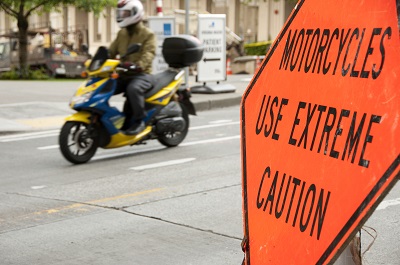
Motorcycle Safety is a Two-way Street
 When spring is in the air, motorcycles are everywhere. Do you long for the freedom that comes with riding on the open road? Then it's critical to respect your machine and improve your skills throughout your lifetime.
When spring is in the air, motorcycles are everywhere. Do you long for the freedom that comes with riding on the open road? Then it's critical to respect your machine and improve your skills throughout your lifetime.
But that's only half the story. Motorists interested only in four-wheeled vehicles still have a major responsibility in keeping motorcyclists safe on the road.
In recognition of National Motorcycle Safety Awareness Month in May, the National Safety Council reminds riders – and drivers – to do their part.
First, Some Stats
In 2017, 5,172 motorcycle riders and passengers died in crashes. Fatalities among motorcycle riders and passengers have more than doubled in number since 1997.
- Motorcycles make up 3% of all registered vehicles and only .6% of all vehicle miles traveled in the U.S.
- Motorcyclists accounted for 14% of all traffic fatalities in 2017
- 28% of riders who died in a motorcycle crash in 2017 were alcohol-impaired
- 91% of riders who died in a motorcycle crash in 2017 were male
Drivers: Do You Ever Think About Motorcycles?
 The vast majority of vehicles on the road are not motorcycles. They're cars and vans and trucks. It's quite possible that as a driver you rarely think about motorcycles.
The vast majority of vehicles on the road are not motorcycles. They're cars and vans and trucks. It's quite possible that as a driver you rarely think about motorcycles.
This is a problem.
"When motorcycles and other vehicles collide, it is usually the other (non-motorcycle) driver who violates the motorcyclist's right of way," according to an issue statement from NHTSA. "There is a continuing need to help other motorists 'think' motorcycles and to educate motorcyclists to be aware of this problem."
Why do drivers often violate motorcyclists' right of way?
- Motorcycles are relatively small and drivers don't see them
- Drivers don't anticipate motorcycles' movements
- The driver's view of the motorcyclist is obstructed, often by the vehicle's blind spots or other vehicles
- The driver is distracted
Driver education programs should emphasize these issues – especially in programs for mature drivers who may have diminished abilities.
36% of All Fatalities in 2017 Were Older Riders
Riders 50 and older made up 36% of all motorcycle fatalities in 2017, according to the Insurance Institute for Highway Safety. So-called "re-entry riders," who rode in their 20s and decided to take it up again in their late 40s to 60s face additional challenges today: more traffic, more powerful bikes, more distracted drivers and diminished physical skills.
If you're going to ride a motorcycle, it's important to commit to a lifetime of learning new skills and brushing up on the old ones.
Read about Baby Boomers and motorcycle safety concerns.
Skill and Gear Can Protect You
A helmet is the most important equipment a biker can use. In 2017, 1,908 motorcyclists who died were not wearing a helmet. Helmets are estimated to be 37% effective in preventing fatal injuries.
- A full-coverage helmet offers the most protection
- Look for the DOT sticker, which guarantees the helmet meets safety standards required by law
- Never buy a used helmet; helmets are useless after they've been worn in a crash
- Here is a fact sheet on motorcycle helmet use from NHTSA
Not every state has a helmet law, but even if yours doesn't, wear one anyway. A motorcycle crash is a "violent event." More than 80% of all reported motorcycle crashes result in injury or death, according to NHTSA. In addition to wearing a helmet:
- Choose a bike that fits you; "supersport bikes" have driver death rates about four times that of cruisers or standard bikes, according to the Insurance Institute for Highway Safety
- Invest in antilock brakes
- New riders should take a motorcycle safety course, and experienced riders should take refresher courses after being off their bikes for a while
- Know the rules of the road
- Be aware that riding with a passenger requires considerably more skill
- Never drink and ride
- Drive defensively, especially at intersections, where half of all collisions occur
- Watch for hazards like potholes, manhole covers, oil slicks, puddles, debris, railroad tracks and gravel
- Assume you are invisible to other motorists and position yourself to be seen
- Use headlights day and night
- Be courteous; don't weave in and out of lanes, or ride on the shoulder or between lanes
- Don't speed
- Wear bright and/or reflective clothing that is durable and boots that cover the ankles
- Wear goggles, glasses or use a face shield that is ventilated to prevent fogging, and make sure it's clear if riding at night
Other Resources
- The Motorcycle Safety Foundation offers safety booklets, downloadable Rider Course handbooks, videos, quick tips, white papers and more. They also can help you find a motorcycle safety course near you.
- RideApart publishes its list of the 10 most common causes for motorcycle accidents and how to avoid them, complete with videos taken by helmet crash cams of what can go wrong.
- The National Highway Traffic Safety Administration created a video on how to selected the right helmet.






